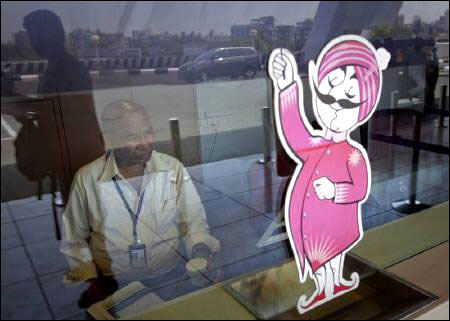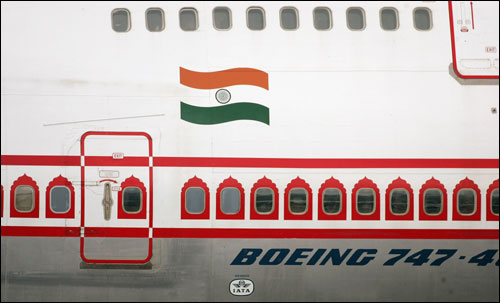Photographs: Punit Paranjpe/Reuters Mihir Mishra in New Delhi
The civil aviation ministry has decided to overhaul the pay structure of Air India employees by scrapping the contentious productivity-linked incentive (PLI) remuneration structure, which constitutes the bulk of salary.
The new structure, meant to reduce the salary bill, will be based on Public Enterprises Selection Board (PESB) guidelines. However, the would not lead to a major salary reduction, as a wage revision is due.
The ministry has decided to restructure the airline's top management by creating a post of joint managing director, who would be an Indian Administrative Services (IAS) officer, to monitor implementation of the still incomplete integration of the erstwhile Air India and Indian Airlines.
Click on NEXT for more...
New wage system for AI, no productivity-linked incentive
Photographs: Vivek Prakash/Reuters
It has decided to prune the number of executive directors (20 at present) and ensure multitasking.
Many of these decisions have been suggested by the Justice Dharmadhikari committee formed last year to recommend ways to integrate the employees of the erstwhile Air India and India Airlines.
Civil Aviation Minister Ajit Singh confirmed the implementation of the committee report. "We have accepted the recommendations of the Justice Dharmadhikari committee and the salaries of Air India employees will be in accordance with PESB guidelines and will not constitute PLIs. The implementation of the report will begin soon," he said.
Click on NEXT for more...
New wage system for AI, no productivity-linked incentive
Photographs: Punit Paranjpe/Reuters
The decision to scrap PLIs will impact about 27,000 employees. PLIs constitute over 60 per cent of Air India's annual wage bill of around Rs 3,000 crore (Rs 30 billion) and are 80-200 per cent of employees' salaries.
With the implementation of PESB norms, the airline will be able to save around Rs 260 crore (Rs 2.6 billion) in the first year itself. A senior ministry official said the saving would be more from the second year.
"The savings would have been more had commitments such as salaries would only increase to the next higher level not been made at the time of the merger," he said.
Click on NEXT for more...
New wage system for AI, no productivity-linked incentive
Photographs: Scott Barbour/Getty Images
Attempts to cut PLIs have met stiff resistance. Former chairman and managing director Arvind Jadhav had to face a pilots' strike after he attempted to cut the PLIs of senior-level employees by around 50 per cent.
Air India, which recently got a bailout package of over Rs 30,000 crore (Rs 300 billion) from the government, is under losses of over Rs 20,000 crore (Rs 200 billion) and has debt on its books of Rs 43,000 crore (Rs 430 billion). Banks are restructuring the airline's debt of Rs 18,000 crore (Rs 180 billion).
The airline will also see changes at the executive director (ED) level. "We cannot remove the EDs just like that; something will be done to decrease the number of such officials in the airline to a permissible level," the official said.
Click on NEXT for more...
New wage system for AI, no productivity-linked incentive
Photographs: Eduard Marmet/Wikimedia Commons
He said the joint MD would report to a committee to be formed in the civil aviation ministry to overlook the integration process.
"We plan to complete the integration process in less than six months," the official said. Staff unions have welcomed the move and said, "PLIs do not make sense for us, as we do not make profits. But at the same time our wage-revision demand should be considered, as our wages have not been revised since 2007," said Arun Kumar Malhotra, general secretary of Air Corporation Employees Unions, the largest union of the airline with 17,000 members.
Malhotra said when PLIs were introduced, the break-even limit for airlines was 19,000 passengers a day, which had increased to 40,000.
"It does not make sense for the airline to pay PLIs on the basis of 19,000 passengers that we get now," he added.







article